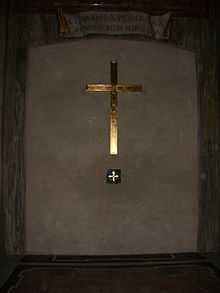Holy door


Each of the four papal basilicas in Rome has a holy door (Porta santa in Italian and porta sancta in Latin). The doors are normally sealed shut from the inside so that they cannot be opened. They are opened during Jubilee years, when pilgrims enter through those doors to gain the plenary indulgence connected with the Jubilee.
It was formerly supposed that this rite was instituted by Pope Alexander VI in the Jubilee of 1500, but this is certainly a mistake. Not to speak of a supposed vision of Pope Clement VI as early as 1350, who is said to have been supernaturally admonished to "open the door", there are several references to the "holy door" or the "golden gate" in connection with the Jubilee long before the year 1475. The earliest account seems to be that of the Spanish pilgrim, Pero Tafur, c. 1437. He connects the Jubilee indulgence with the right of sanctuary, which, he maintains, existed in pagan times for all who crossed the threshold of the puerta tarpea upon the site of the Lateran. He goes on to say that, at the request of Constantine, Pope Sylvester I published a Bull proclaiming the same immunity from punishment for Christian sinners who took sanctuary there. The privilege, however, was grossly abused, and the Popes consequently ordered the door to be walled up at all seasons except during certain times of special grace. Formerly the door was unwalled only once in a hundred years, this was afterwards reduced to fifty, and now it is said to be "opened at the will of the Pope." However legendary all this may be, it is unlikely that the story could have been quite recently fabricated at the time Tafur recorded it. Moreover, a number of witnesses allude to the unwalling of the holy door in connection with the Jubilee of 1450. One of these, the Florentine merchant Giovanni Rucellai, speaks of the five doors of the Lateran basilica,
one of which is always walled up except during the Jubilee year, when it is broken down at Christmas when the Jubilee commences. The devotion which the populace has for the bricks and mortar of which it is composed is such that at the unwalling, the fragments are immediately carried off by the crowd, and the foreigners (gli oltremontani) take them home as so many sacred relics… Out of devotion every one who gains the indulgence passes through that door, which is walled up again as soon as the Jubilee is ended.
All this describes a rite which has lasted unchanged to the present day, and which has nearly always supplied the principal subject depicted upon the long series of Jubilee medals issued by the various Popes who have opened and closed the holy door at the beginning and end of each Jubilee year. Each of the four basilicas has its holy door. That of St. Peter's is opened on the Christmas Eve preceding the anno santo by the pontiff in person, and it is closed by him on the Christmas Eve following, using a special ornamental trowel to put the first bit of concrete. Until the Great Jubilee of 2000, the Pope knocked upon the door three times with a silver hammer, singing the versicle "Open unto me the gates of justice". The masonry, which had been loosened beforehand, was made to fall in at the third blow. After the threshold was swept and washed by the Jubilee penitentiaries, the Pope entered first. Each of the holy doors at the other basilicas is similarly opened by a cardinal specially deputed for the purpose. The symbolism of this ceremony is probably closely connected with the idea of the exclusion of Adam and Eve from Paradise, and the expulsion and reconciliation of penitents according to the ritual provided in the Pontifical. But it may also have been influenced by the old idea of seeking sanctuary, as Tafur and Rucellai suggest. The sanctuary knocker of Durham Cathedral still remains to remind us of the important part which this institution played.[citation needed]
Pope John Paul II simplified the ceremony for the Great Jubilee of 2000 for safety reasons; previously, debris had fallen on Pope Paul VI while striking down the door. Workers had removed the concrete before the ceremony of the opening of the door so that the Pope only had to push on the doors with his hands. The holy door of St. Peter's Basilica was opened by the Pope on 24 December 1999 while the doors of St. John Lateran and St. Mary Major were opened on 25 December and 1 January, respectively. Breaking with tradition, the Pope opened both of these personally, rather than delegating this to a cardinal. The doors of Basilica of Saint Paul Outside the Walls were opened in an ecumenical ceremony on 18 January, first day of the World Week of Prayer for Christian Unity by the Pope, the Archbishop of Canterbury and a representative of the Ecumenical Patriarch. The door in St. Peter's was closed on 6 January 2001, with the others being closed one day earlier.
Above the holy door in St. Peter's are marble memorial plates commemorating the last two times that the door has been opened. Since John Paul II held the last two Jubilees, both plates indicate that he opened and closed the door.
Other major pilgrimage churches, such as the Cathedral of Santiago de Compostela, also have holy doors with similar functions. Notre-Dame Basilica-Cathedral (Quebec City) will have one until December 2014.[1]
- ↑ Toronto Star website, 7 December 2013